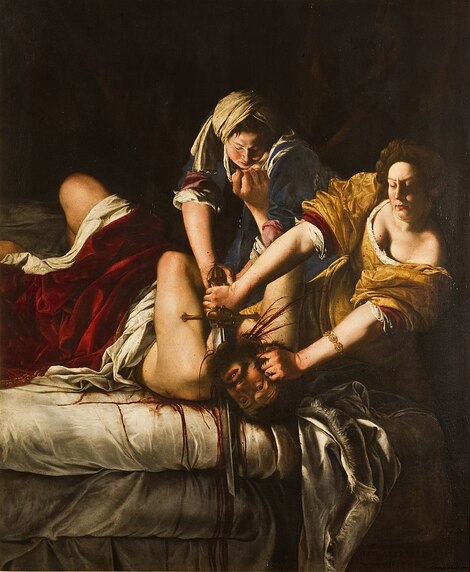|
Where? Room 90 of the Uffizi Museum
When? c. 1620 Commissioned by? Grand Duke of Tuscany, Cosimo ll De’ Medici. The Grand Duke died in 1621, shortly after the painting was completed. It was only with the help of Artemisia’s friend, Galileo Galilei, that she managed to extract the payment for the agreed sum for the canvas. Medium and Size: Oil on canvas, 146.5 x 108.0 cm. What do you see? The moment that Judith, with the help of her maidservant Abra, is beheading the Assyrian general Holofernes. Unlike many other artists, Artemisia Gentileschi chose to portray the scene at its zenith. It is the most powerful and horrific moment to imagine. Holofernes still struggles, his right hand fruitlessly trying to jab at Abra. His soon-to-be lifeless forearm comes to rest in the crook of her shoulder. His right knee is bent in a futile attempt to escape. Abra’s arms press downwards with great strain to hold Holofernes’ left arm down and still. The concentration and intense focus on what she is doing registers in her facial expression. Abra’s hair is covered with a white turban, and she wears a blue dress. The white sheet and the red coverlet lay rumpled over the commander. The sword's thrust in Judith’s hand produces blood spurts that reach Abra’s arm and Judith’s dress and body. Blood seeps over the bed and down the edges as life drains from him. His face is already losing the expression that gives it life, and it will soon be tucked into the food bag, wrapped in the bejeweled cloth that will be triumphantly removed once the two Jewish women return to their hometown Bethulia. Judith strains! The force she is expending is visible as she clutches the hair on Holofernes head and presses his head into the mattress with her left arm. Her right arm twists and rotates as the sword makes its cut. She uses the sword of Holofernes. The edge of the cross on the sword digs into the skin of his upper left arm, and we can see the pressure on it. Sleeves rolled up on both the women suggest they had some time to prepare, at least a bit, beforehand. He must have been quite drunk. The gown that Judith is wearing attests to the seduction that was her purpose. The low cut of the dress exposes her breasts and must have been enticing to Holofernes. Her hair is coiffed in the style of a noblewoman, uncovered, revealing its charms. She apparently was perfumed and prepared to seduce. Artemisia has painted one of her own bracelets on Judith’s arm in this second version of the scene. One cameo depicts Artemis, the ancient goddess of chastity and the hunt. It raises the question of whether Artemisia identified with this goddess? The textured walls of the tent provide a dark backdrop that not only frames the scene but also produces the contrast between light and dark that intensifies the actions of each individual. The light source comes from the left. The composition of the three figures focuses the viewer’s attention on the central part of the canvas.
0 Comments
|
Categories
All
|
- Home
- Blog
-
Museums
- Alte Pinakothek
- Art Institute of Chicago
- Baltimore Museum of Art
- Barber Institute of Fine Arts
- Bargello
- Barnes Foundation
- British Museum
- Church of Sant’Anastasia
- Cleveland Museum of Art
- Courtauld Institute of Art
- Detroit Institute of Arts
- Frans Hals Museum
- Galleria Borghese
- Gallerie dell'Accademia
- Getty Museum
- Guggenheim
- Hermitage Museum
- Kunsthistorisches Museum
- Kunstmuseum Basel
- Legion of Honor Museum
- Louvre
- Mauritshuis
- Metropolitan Museum of Art
- Musee d’Orsay
- Museum of Fine Arts in Boston
- Museum of Modern Art
- National Gallery in London
- National Gallery of Art
- National Museum in Poznań
- Norton Simon Museum
- Ny Carlsberg Glyptotek
- Palace of Versailles
- Palazzo Pitti
- Palazzo Vecchio
- Petit Palais
- Philadelphia Museum of Art
- Prado
- Pushkin Museum
- Ravenna Art Museum
- Rijksmuseum
- San Diego Museum of Art
- Santa Maria delle Grazie
- St. Peter's Basilica
- Städel Museum
- Statens Museum for Kunst
- Tate Britain
- Tate Modern
- Timken Museum of Art
- Uffizi
- Vatican Museums
- Wallace Collection
-
Artists
- Altdorfer
- Anguissola
- Berlin Painter
- Bosch
- Botticelli
- Boucher
- Bronzino
- Bruegel the Elder
- Brunelleschi
- Cabanel
- Caillebotte
- Canova
- Caravaggio
- Carpeaux
- Cezanne
- Cimabue
- David
- Degas
- Delacroix
- De Maria
- Donatello
- El Greco
- Fontana
- Fra Angelico
- Fragonard
- Gauguin
- Gentileschi
- Gericault
- Gonzalez-Torres
- Goya
- Hals
- Hogarth
- Hokusai
- Ingres
- Leonardo da Vinci
- Lippi, Filippo
- Longhi, Barbara
- Lorrain
- Makovsky
- Manet
- Massys
- Matisse
- Merian
- Michelangelo
- Mochi
- Modigliani
- Monet
- Panini
- Parmigianino
- Perugino
- Picasso
- Pisanello
- Raphael
- Rembrandt
- Renoir
- Reynolds
- Rivera
- Rodin
- Rubens
- Scultori
- Seurat
- Steen
- Tintoretto
- Titian
- Toulouse-Lautrec
- Turner
- Uccello
- Van der Weyden
- Van Dyck
- Van Eyck
- Van Gogh
- Van Hemessen
- Vasari
- Velazquez
- Vermeer
- Veronese
- Vigée Le Brun
-
Locations
- Books
- About Us

